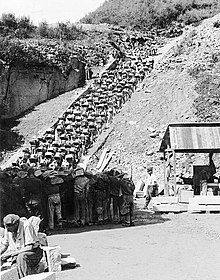
Back الإبادة من خلال العمالة Arabic Vernichtung durch Arbeit German Exterminación mediante trabajos forzados Spanish پاکسازی از راه کار اجباری FA Extermination par le travail French השמדה באמצעות עבודה HE Pembunuhan dengan bekerja ID Sterminio tramite il lavoro Italian 労働を通じた絶滅 Japanese Wyniszczenie przez pracę Polish


Extermination through labour (or "extermination through work", German: Vernichtung durch Arbeit) is a term that was adopted to describe forced labor in Nazi concentration camps whose inmates were held in inhumane conditions and suffered a high mortality rate; in some camps most prisoners died within a few months of incarceration.[1] In the 21st century, research has questioned whether there was a general policy of extermination through labor in the Nazi concentration camp system because of widely varying conditions between camps.[2] German historian Jens-Christian Wagner argues that the camp system involved the exploitation of forced labor of some prisoners and the systematic murder of others, especially Jews, with only limited overlap between these two groups.[1]
Some writers, notably Aleksandr Solzhenitsyn, have written that the Soviet Gulag system was also a form of extermination through labour. Similar statements have been made about the Laogai system under Mao Zedong's China.
- ^ a b WAGNER, JENS-CHRISTIAN (2009). "Work and extermination in the concentration camps". Concentration Camps in Nazi Germany. Annihilation through labour?: Routledge. pp. 139–160. doi:10.4324/9780203865200-12. ISBN 978-0-203-86520-0.
- ^ Buggeln, Marc (2009). "Building to Death: Prisoner Forced Labour in the German War Economy — the Neuengamme Subcamps, 1942—1945". European History Quarterly. 39 (4): 606–632. doi:10.1177/0265691409342658. S2CID 10534453.